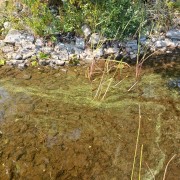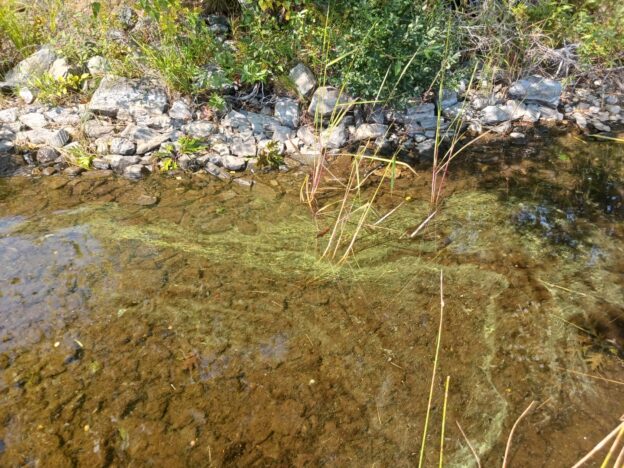 Some of you might have noticed a little green algae collecting on your shoreline over the last couple of days. This is dead cyanobacteria that floats to the surface and gets pushed around by a gentle breeze. It dissipates fairly quickly so it’s easy to miss, it is what is often referred to as an “ephemeral algal bloom”. As the lake cools off and the thermocline breaks down, Phosphorus from the bottom of the lake starts to mix with the epilimnion (upper water layer) and it stimulates some algae growth. This is fairly normal this time of year for a mesotrophic lake like Clary. We’ve seen much worse. These events are usually so ephemeral that they often go unnoticed, especially with fewer people on or near the water at this time of year. I think we’ll avoid a severe bloom this fall thanks the low Phosphorus levels in the lake this summer: our August 11th water sample for Total Phosphorus testing came back at a paltry 11 µg/L (micrograms per liter) which is a record low value for Clary Lake going back to 1975. We’ll be taking one final water sample for TP testing next weekend.
Some of you might have noticed a little green algae collecting on your shoreline over the last couple of days. This is dead cyanobacteria that floats to the surface and gets pushed around by a gentle breeze. It dissipates fairly quickly so it’s easy to miss, it is what is often referred to as an “ephemeral algal bloom”. As the lake cools off and the thermocline breaks down, Phosphorus from the bottom of the lake starts to mix with the epilimnion (upper water layer) and it stimulates some algae growth. This is fairly normal this time of year for a mesotrophic lake like Clary. We’ve seen much worse. These events are usually so ephemeral that they often go unnoticed, especially with fewer people on or near the water at this time of year. I think we’ll avoid a severe bloom this fall thanks the low Phosphorus levels in the lake this summer: our August 11th water sample for Total Phosphorus testing came back at a paltry 11 µg/L (micrograms per liter) which is a record low value for Clary Lake going back to 1975. We’ll be taking one final water sample for TP testing next weekend.
Minor algal blooms like this do not pose a health risk for humans or animals.

